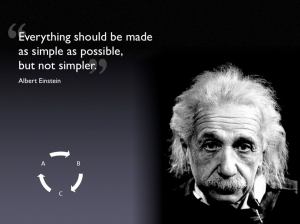T
Trevor
Guest

Albert Einstein is known to say: “Everything should be made as simple as possible, but not simpler.” This quote came up at a PMI lunch ‘n’ learn I attended this week. It was related to project management, but really, I couldn’t help but think of the entire presentation as a metaphor for Manufactured Spending (MS). Without going into too much detail on the presentation, I will say that there were no meaningful circles or arrows.
As simple as possible
Manufacturing spending, at the “simple” level, is spending for the sheer purpose of generating miles, points, or cash back. The most logical approaches are those which are simple: A-B-A. We’ve seen those deals, but they don’t scale well. Then we have A-B-C-A, which we’ve found scale better, but are often at the mercy of the fickleness of point of sale (POS) machines, cashiers and customer service representatives. I’m being particularly non-specific with respect to MS techniques, not because I’m trying to be obtuse, but rather because I think its important to look at the basic things that work. See if this logic works with some of the techniques you use. How many letters do you go through before you get back to A? In theory, you could use much more complex methods, that use A-B-C-D-A, or even more. However each letter introduces complexity and risk.
Juxtaposition with Reselling
If you apply the same logic to reselling, you can do a simple A-B-C-A, where B is product (for simplicity, we’ll consider purchased/put on sale as the same, and C is product sold). You can get more complicated with buying merchant gift cards as FrequentMiler, Chasing the Points, BigHabitat and others (disclosure: I got tired of googling for examples), have written about, but again, that added complexity introduces risk.
But not simpler
I think this is the difficult point. Just as it is possible to over simplify in words, I think graphics occasionally push it even further. What I mean here, is that some folks, right or wrong, introduce arrows, circles, and other things, that may be considered “simpler.”
Now, I am no scientist, nor am I a physicist. I happen to know one pretty well though (my wife), so I don’t think I’m too far off the mark, in saying that there Einstein probably believed that people should experiment for themselves. Of course, in trying to verify this, the best I could find was that fish shouldn’t climb trees, yet nothing about teaching a man to fish.
But I digress. Manufactured Spending should be made simple, but not simpler. To make MS simpler puts techniques at risk. Arrows and circles, I would argue, fall into the “Simpler” category.
How this approach can work for you
Much like I referred to in how much detail of a deal to share, the the scientific method is certainly a viable option.

Really, the key is to find the most efficient, scalable solution. I believe it is an A-B-C-A approach. I won’t give you the answers to the quiz, so to speak, but I will offer that, you should be able to scale a 2 part MS solution. I certainly do, but I’m small time, I don’t break six figures a month. I know others that do. I just don’t have the time. I suppose I’d consider myself a “weekend warrior” in that regard, because nine times out of ten, when I MS, its Friday, Saturday, Sunday.
Conclusion
Even as a Weekend Warrior, I still do pretty well, and you can too. But be smart. Consider the opportunities, consider the risks, and consider what works for you. Don’t ask the Walmart Cashiers if you can use a gift card. Do your research before you walk in. When you’re in the store (Walmart or otherwise), exude confidence. Its contagious. Finally, keep trying new things, create your hypothesis, test it, repeat it, and share it with those you trust, but leave the circles and arrows out of it. I dare say that would fall into the simpler category.
Continue reading...
